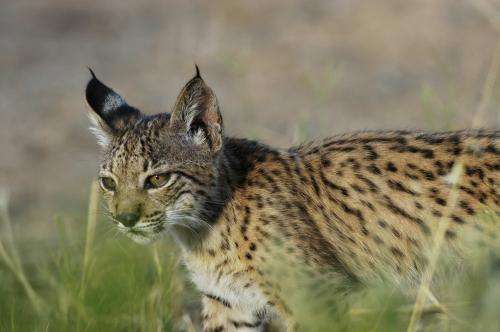Cryopreservation: A chance for highly endangered mammals

Oocytes of lions, tigers and other cat species survive the preservation in liquid nitrogen. Scientists of the Leibniz Institute for Zoo and Wildlife Research (IZW) in Berlin succeeded in carrying out cryopreservation of felid ovary cortex.
"We have successfully frozen and thawed oocytes in the ovary cortex of different cat species at minus 196 degrees Celsius. This freezing process and the storage of living cellular material in liquid nitrogen is called cryopreservation", said Caterina Wiedemann, doctoral candidate at the IZW.
The ovarian cortex is regarded as a reservoir of reproductive cells. It contains thousands of immature oocytes. Successful cryopreservation of ovarian tissue of wild cats is therefore a key element for the establishment of genome resource banks, an important tool for the preservation of genetic diversity. All felid species except for the domestic cats are listed on the Red List for endangered species of the International Union for Conservation of Nature (IUCN).
Taking a freezing procedure developed in human medicine as their model, scientists at the Department of Reproduction Biology of the IZW developed a method for cryopreserving the ovarian cortex of different cat species. In the original procedure, ovarian tissue of women who suffer from cancer is removed to avoid its damage by chemotherapy or radiotherapy. After successful tumor treatment the tissue is re-transplanted so that the normal female cycle, including fertility, can be restored. In the meantime, the tissue is conserved in liquid nitrogen. The IZW adapted this method to preserve female germ cells from feline species.
The particular challenge in the cryopreservation of ovarian cortex tissue comes from the fact that the cells are embedded in a very complex system. Ovarian cortex is composed of immature oocytes surrounded by small somatic cells, different connective tissue and blood vessel cells. In addition, the cellular properties of every species are unique, thus it not possible to develop a common freezing procedure applicable to all species. For the cat cells, the scientists of the IZW worked out a "slow" freezing protocol. The cortex was dissected into evenly chopped pieces, each 2 mm in diameter. The cellular material was frozen at a speed of 0.3 degrees per minute. Ethylene glycol and saccharose were used as cryoprotectant agents. To demonstrate their survival after thawing the ovaries, the cortex was cultured in a medium for up to 14 days before and after the freezing.
The IZW owns the genome resource bank "Arche", which contains, inter alia, a variety of sperm samples of various wildlife species. The newly developed cryopreservation method will substantially improve the future storage of feline germ cells.
"This is a large step towards preserving biodiversity. In particular to endangered cat species the successful cryopreservation of female and male gametes is a ray of hope", commented the head of the department, Prof Dr Katarina Jewgenow (IZW).
In 2007 the IZW initiated the "Felid Gametes Rescue Project" in order to build up an European network for the extraction and storage of feline gametes, which are made available to breeding programmes of zoos. Within the framework of this project, different European zoos are sending ovaries and testes of big and small cats to the IZW in Berlin for research. The scientists involved are confident that these good results will encourage even more zoos to participate in the network.
More information: Wiedemann C, Zahmel J, and Jewgenow K (2013): Short-term culture of ovarian cortex pieces to assess the cryopreservation outcome in wild felids for genome conservation. BMC VET RES 9, 37; doi: 10.1186/1746-6148-9-37
Provided by Forschungsverbund Berlin e.V. (FVB)

















